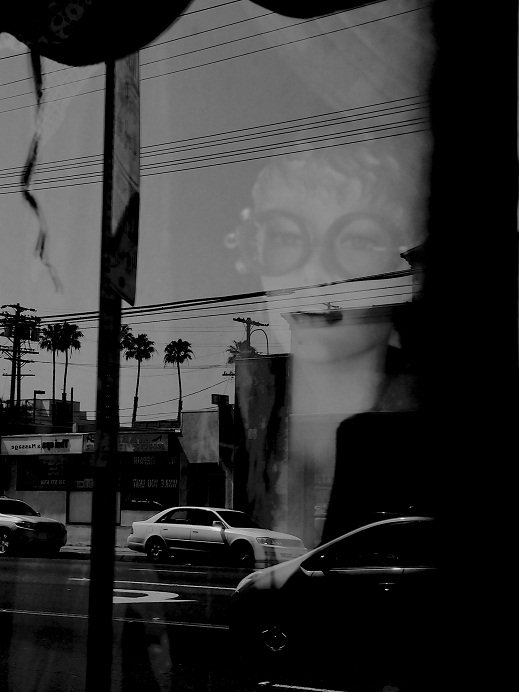Ghosting, Invisibility and the Erasure of Particular Bodies: A Spell by Chris Abani
Introduction by Poetry Editor Nathan McClain:
At our 20th annual Cave Canem Retreat last week, I learned that a camera, no matter how good a camera, is mechanical. This sounds like a simple statement, I know, but what it means is that a camera doesn’t see what you see; a camera only sees what’s in front of it. A “good shot” isn’t on account of owning a good camera. Our role, as poet and/or photographer, is not only learning to “see,” but also learning to frame what you “see” (so the camera also sees). This practice requires a fundamental understanding of image which, in either a photograph or a poem, is, or should be, our primary focus. “Every poem is essentially an image” and, according to Chris Abani (who I’ll paraphrase in great detail here), who recently sat with me and discussed photography, and image in particular, “every image [as, I hope, you’ll see] is composed of three parts: a striking visual image (which occupies the focal point), movement (which creates depth of field) and sound.” (In a photograph, sound is always implied because you can’t hear it). Understand that when Abani references a photograph, he is differentiating between a “photograph” and a “snapshot” to which, in our current dispensation, we are constantly exposed. Hello, Snapchat. Hello, Instagram. A “snapshot” is an image that has no connection to us beyond the representation of the moment; it holds nothing beyond the materials of its composition. It’s anecdotal. A “photograph,” conversely, is never a representation of life, as that would cause the image to be static, flat. It’s an image that reveals the limits of its individual material components and reaches beyond the frame. The photograph, the poem, is about invoking presence. The self is (and should be) implicated. We try to find apertures which are closed, so we can open them. This creates empathy because, to paraphrase Baldwin, “your suffering means something only inasmuch as someone else can connect their suffering to yours.” Our trauma creates an aperture for someone else’s trauma.
Abani was kind enough to provide us with a small photo essay. Originally, when I considered the photo essay, I thought “argument,” but it’s really a conversation. Persuasion (or rhetoric) functions in that it limits the frame for you. Framing, or positioning, conveys intent. When a photo essay is built, one whittles down until the image is found, and then images that create tension with other images. Enough narrative is provided to engage a viewer, but enough lyric space is left so other narrative and emotional possibilities are available for the image. A viewer leans into it…
__________
*
Fair warning, I am a tatterdemalion.
*

*
As in all meditations around photographs, words must take second place to the image, which should hold all the profundity, as words are mere facsimiles of the actual. Nonetheless.
*
Women, embodied and alive resist inscription. Not in the sense of striving toward or against, but rather in the sense of presence: the state of being present, a fact of body and all that derives from it. Women ARE.
*

*
The masculine gaze attempts to temper women to desire, lust, hunger, and a need that makes men the center of the world. But women can’t be overwritten easily because we cannot overwrite what IS.
*

*
British sculptor Antony Gormely thinks of the human body as a “place of habitation.” He makes art by using his body, or the bodies of those who live in the areas his work will be shown. This art is a direct mold of their bodies, I think, in hope of locating how we inhabit bodies, since once the sculpture goes into the world, the audience inhabits them. This kind of site-specific installation is simultaneously mobile and resists easy inscription in this way.
*

*
The masculine drive to shape women’s bodies to desire and need, one that can be magically harnessed to any object in order to magnify its appeal, requires an evacuation first. This may seem counter-intuitive but it isn’t – to make a woman with large breasts hypersexual, or to make blonde hair signify stupidity, or to make glasses signify smartness is to transform women into mannequins, to remove the self. And since this is impossible the fabrication begins on the outside, a way of shaping perception such that even the self inhabiting the body questions her own understanding of it.
*
Seeing this window installation in LA I was drawn to the mannequins. Since the conceit was the future, it saddened me to see that even in the future, even in a post-apocalyptic world, women are still positioned within the masculine gaze. The reflected consumer products, one of them a cell phone company logo lodged firmly in one mannequin’s throat, seemed to indicate a silence. The skulls, usually associated with hunters and masculine prowess when mounted, were further signs of inscription. And yet, there is something about these mannequins that made me think of Antony Gormely and I realized that what had happened here, by a curious trick of the light, of seeing, was that I was compelled to seek habitation in these bodies, to find myself in them. There was something in their positioning that invoked their presence, the fact of them, the possibility of them, and the negation of the act of patriarchy.
*

*
But the images must speak for themselves. I am, in this regard a tatterdemalion, which is to say you must not take my word for it. I am after all, a man.
- Published in Series
